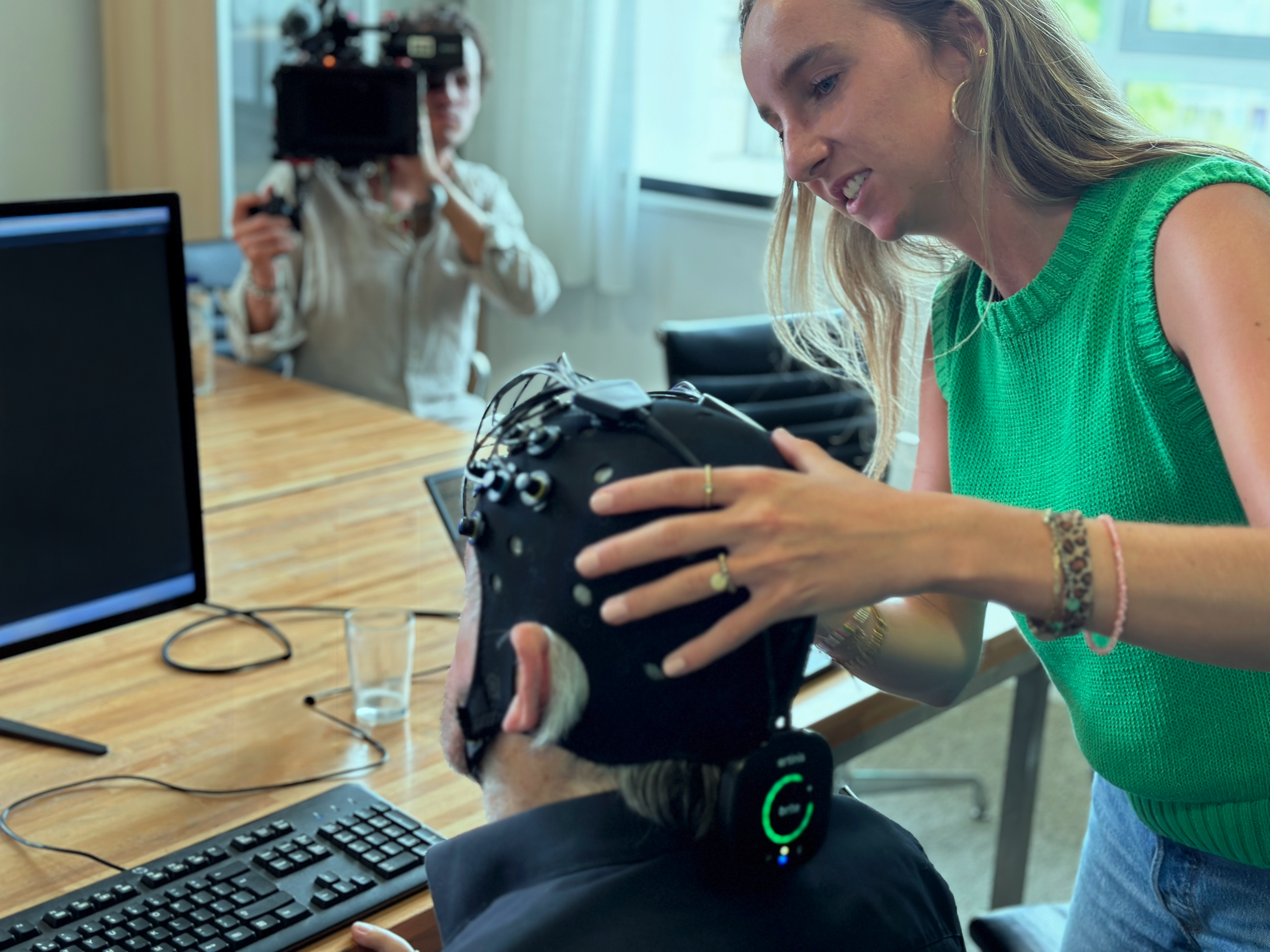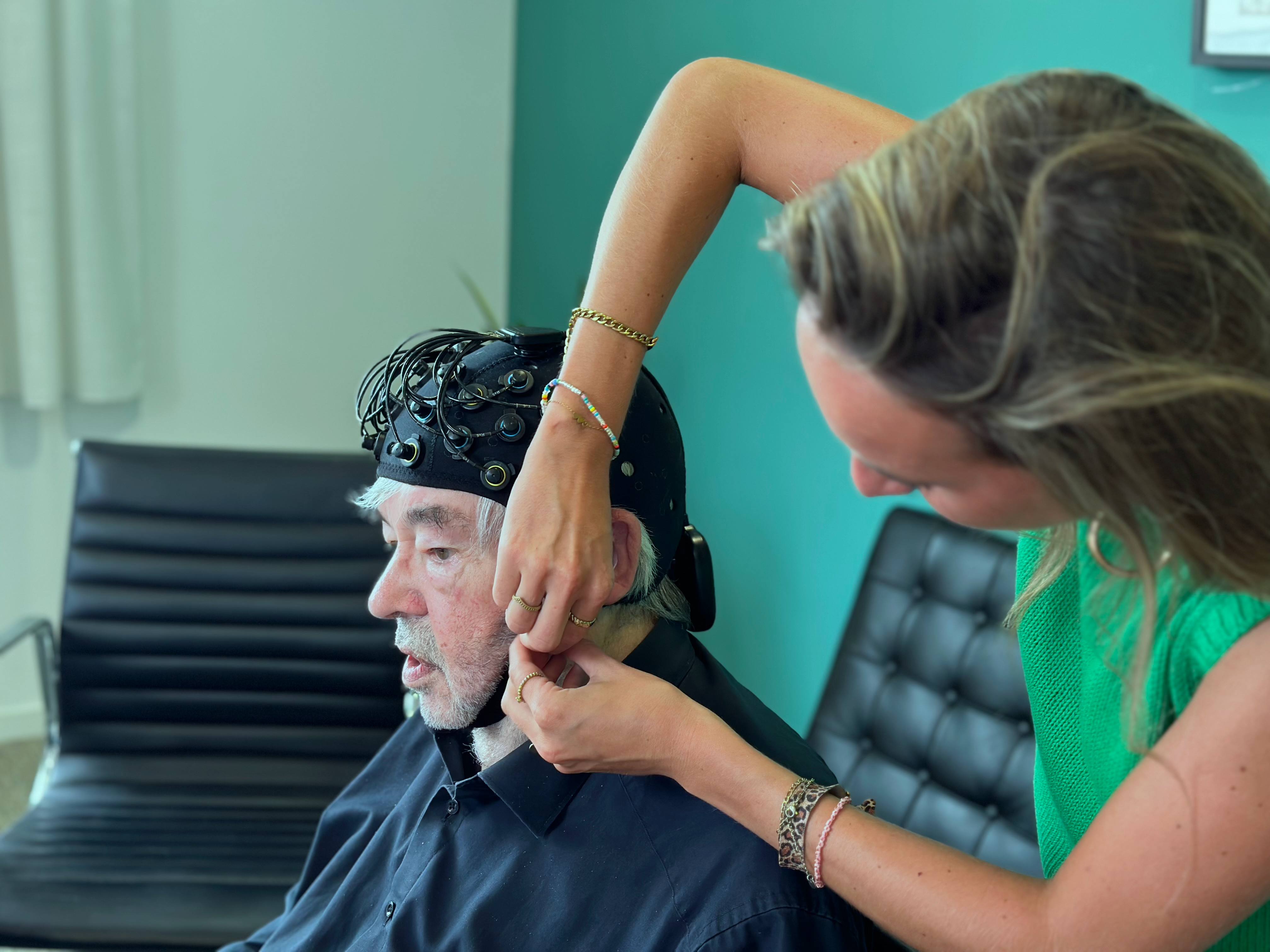The Happiness of Wortelboer and Van Rossem
Maybe you watched the first episode of Wortelboer & Van Rossem, where Emma and Maarten went in search of their personal happiness. But how do you really find out what makes someone’s heart beat faster? What gets the happiness hormone flowing? When does someone truly feel happy? Is it as simple as just asking them?
According to science, the answer lies a bit deeper—namely, in the brain. That’s why Maarten and Emma visited Neurensics for the new season of their show, to measure their happiness directly in the brain.
What people feel isn't always what they say
Our brain is a fascinating yet complex organ. We often think we know exactly what we want or feel, but when we try to explain it or fill out a questionnaire, it doesn’t always match what’s really going on in our minds. We respond based on social desirability—or we simply lack the knowledge and insight to truly understand what drives and motivates us deep down.
That’s why at Neurensics, we deliberately take a different approach: we look directly into the brain. Unconscious responses often provide a much more reliable picture of how people really feel—and how they’re likely to behave as a result. Because while people may say one thing, their automatic, unconscious reactions reveal what’s truly going on, even before they’ve had a chance to think about it themselves.

Happiness made visible with fNIRS
To map out what makes Maarten and Emma feel happy, we used fNIRS—a cutting-edge neuro-imaging technique that measures brain activity using infrared light. Alongside EEG and fMRI, which are also widely used at Neurensics, fNIRS is easy to apply in natural settings and was particularly well-suited for this setup thanks to its high measurement precision.
Wearing the fNIRS cap, Emma and Maarten viewed a variety of images expected to evoke specific emotions—from irresistible chocolate to less appealing moldy sandwiches. Their brain responses to these images served as reference points: emotional benchmarks that allowed us to gauge the intensity and positivity of their reactions to other visuals.
Once these emotional reference points were established, things got interesting. Emma and Maarten were shown images of various activities: going out, reading, watching TV, traveling to faraway places, scenes of Texel, and typical Dutch moments. Their brain activity was continuously measured using fNIRS—without asking a single question. The responses were then compared to the benchmark material.
And what did we find?
Maarten and Emma turn out to be more alike than they thought.
Despite being constantly in the spotlight and surrounded by busy schedules, the analysis revealed that Emma and Maarten primarily find joy in peace and solitary happiness. Not from crowded parties or bustling events, but rather from having time to themselves, without others around. Neither of them has much interest in yoga retreats or noisy restaurants. For Maarten, happiness means unwinding with a good book. Emma, surprisingly, responded very positively to museums—something that likely delights historian Van Rossem. He’s probably eager to plan a cultural day out. Whether Emma can still enjoy his lectures once they’re there remains to be seen. We also discovered that Emma really enjoys watching television. In short, rest and solitude are key for both to recover from their hectic lives.
And a few other striking insights emerged:
- Maarten hardly gets emotionally moved by typical Dutch imagery. Flags, street scenes, and heroic sports moments barely triggered positive emotions in his brain—it just doesn’t seem to register.
- Emma, on the other hand, experienced something entirely different. Although she may not readily admit it, her brain showed clear activation patterns indicating that images evoking national pride did indeed trigger more positive emotions. Deep down, Emma turns out to be just a little bit patriotic.
- And although Maarten has vacationed on the Wadden Island Texel for years, his brain responded more strongly to images of an Indonesian volcano than to those of his beloved Texel. Emma also found the Indonesian volcano highly appealing.
Could this be a trip worth considering for their next season?
This little device measures brain activity at the front of the head. It’s ideal for detecting whether someone is irritated by something, if something strongly grabs their attention, if they’re confused—or whether something truly resonates with them. Andries van der Leij, Head of Research & Development - Neurensics

What does this mean for brands and products?
At Neurensics, we apply the same scientifically grounded techniques to brand, product, and experience perception. We measure emotions and unconscious responses to accurately predict how consumers will actually react to advertisements, packaging, or in-store experiences. For example:
-
How can you find out whether your advertisement activates the right emotions?
Read all about it in this Achmea case study. - 'How to create an effective story telling video?' -
Why do certain packaging designs trigger purchase intent, while others are simply ignored?
Find out in the Philips case study. - 'Right-handed packaging visuals is better than left handed ones' -
How do you design a space—based on brain insights—where people enjoy being and can work productively?
Find the answer in the Hoogerwerf case study - 'Goodbye open-plan office - How to design a workspace with neuromarketing insights'
At Neurensics, we combine in-depth insights from neuroscience with practical applications that truly work. Our methods are scientifically validated and backed by quality—thanks in part to our close collaboration with leading scientists at the University of Amsterdam.
Feeling inspired and want to learn more about how neuroscience can benefit your brand or organization?
Explore the possibilities here, or feel free to get in touch with us directly—no strings attached!
Your brain knows more than you think.
Blogs
Get in contact
Vladimir den Baars
Client Director
Want to know more about the research possibilities?

Andries van der Leij
Head of Research & Development
Want to learn more about the techniques we use?

Start a project
Do you have questions about what Neurensics can do for your company? Get in contact with Vladimir.

Vladimir den Baars
Learn more about the Neuro-research techniques.
Do you have questions about the research techniques used by Neurensics? Get in contact with Andries.














